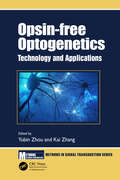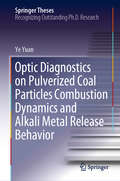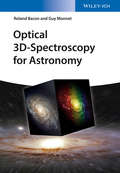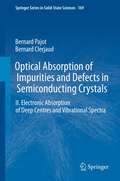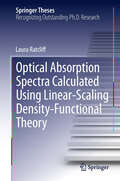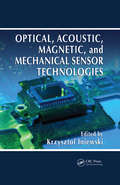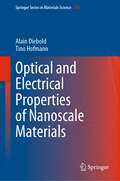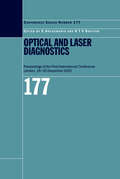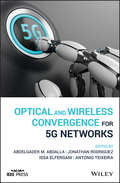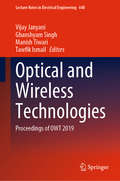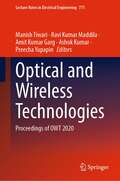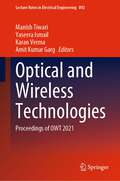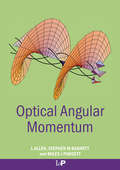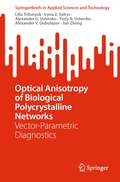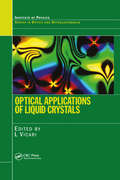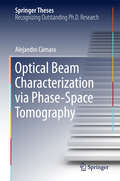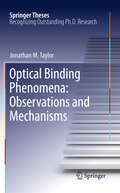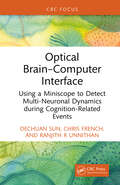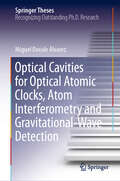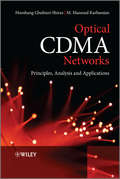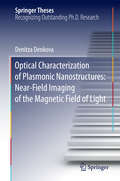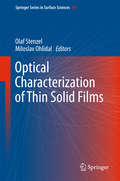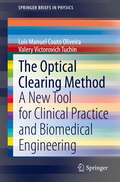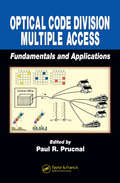- Table View
- List View
Opsin-free Optogenetics: Technology and Applications (Methods in Signal Transduction Series)
by Yubin Zhou Kai ZhangOptogenetics represents a breakthrough technology capable of dynamically modulating molecular and cellular activity in live cells with high precision. This transformative technology made it possible to reversibly interrogate protein actions, cellular events, and animal behaviors with a simple flash of light. Manipulating the temporal and spatial profile of light enabled precise control of membrane potentials. This feature has inspired non-opsin-based optogenetics, which not only inherits the precise spatiotemporal resolution but also expands the targets into a diverse pool of biomolecules such as membrane receptors, ion channels, kinases, GTPases, and transcription factors. This book is unique because it emphasizes the design and applications of opsin-free optogenetic tools. Key Features Describes new developments in non-opsin-based optogenetic tools Introduces cutting-edge methods for precise modulation of cell signaling Highlights applications of optogenetic regulation of cellular functions Covers contributions from an international team of leading experts Related Titles Lim, W. & B. Mayer – Cell Signaling (ISBN 9780815342441) Ayyanathan, K., ed. – Cancer Cell Signaling: Targeting Signaling Pathways Toward Therapeutic Approaches to Cancer (ISBN 9781774630839) Zhang , J. et al., eds. – Optical Probes in Biology (ISBN 9781138199934)
Optic Diagnostics on Pulverized Coal Particles Combustion Dynamics and Alkali Metal Release Behavior (Springer Theses)
by Ye YuanThis book focuses on pulverized coal particle devolatilization, ignition, alkali metal release behavior, and burnout temperature using several novel optic diagnostic methods on a Hencken multi-flat flame burner. Firstly, it presents a novel multi-filter technique to detect the CH* signal during coal ignition, which can be used to characterize the volatile release and reaction process. It then offers observations on the prevalent transition from heterogeneous ignition to hetero-homogeneous ignition due to ambient temperature based on visible light signal diagnostics. By utilizing the gap between the excitation energies of the gas and particle phases, a new low-intensity laser-induced breakdown spectroscopy (PS-LIBS) is developed to identify the presence of sodium in the particle or gas phase along the combustion process. For the first time, the in-situ verification of the gas phase Na release accompanying coal devolatilization is fulfilled when the ambient temperature is high enough. In fact, particle temperature plays a vital role in the coal burnout process and ash particle formation. The last part of the book uses RGB color pyrometry and the CBK model to study the char particle temperature on a Hencken burner. It offers readers valuable information on the technique of coal ignition and combustion diagnostics as well as coal combustion characteristics.
Optical 3D-Spectroscopy for Astronomy
by Guy Monnet Roland BaconOver the last 50 years, a variety of techniques have been developed to add a third dimension to regular imaging, with an extended spectrum associated to every imaging pixel. Dubbed 3D spectroscopy from its data format, it is now widely used in the astrophysical domain, but also inter alia for atmospheric sciences and remote sensing purposes. This is the first book to comprehensively tackle these new capabilities. It starts with the fundamentals of spectroscopic instruments, in particular their potentials and limits. It then reviews the various known 3D techniques, with particular emphasis on pinpointing their different `ecological? niches. Putative users are finally led through the whole observing process, from observation planning to the extensive ? and crucial - phase of data reduction. This book overall goal is to give the non-specialist enough hands-on knowledge to learn fast how to properly use and produce meaningful data when using such a 3D capability.
Optical Absorption of Impurities and Defects in Semiconducting Crystals
by Bernard Pajot Bernard ClerjaudThis book outlines, with the help of several specific examples, the important role played by absorption spectroscopy in the investigation of deep-level centers introduced in semiconductors and insulators like diamond, silicon, germanium and gallium arsenide by high-energy irradiation, residual impurities, and defects produced during crystal growth. It also describes the crucial role played by vibrational spectroscopy to determine the atomic structure and symmetry of complexes associated with light impurities like hydrogen, carbon, nitrogen and oxygen, and as a tool for quantitative analysis of these elements in the materials.
Optical Absorption Spectra Calculated Using Linear-Scaling Density-Functional Theory
by Laura RatcliffThe development of linear-scaling density functional theory (LS-DFT) has made ab initio calculations on systems containing thousands of atoms possible. These systems range from nanostructures to biomolecules. These methods rely on the use of localized basis sets, which are optimised for the representation of occupied Kohn-Sham states but do not guarantee an accurate representation of the unoccupied states. This is problematic if one wishes to combine the power of LS-DFT with that of theoretical spectroscopy, which provides a direct link between simulation and experiment. In this work a new method is presented for optimizing localized functions to accurately represent the unoccupied states, thus allowing theoretical spectroscopy of large systems. Results are presented for optical absorption spectra calculated using the ONETEP code, but the method is equally applicable to other spectroscopies and LS formulations. Other topics covered include a study of some simple one dimensional basis sets and the presentation of two methods for band structure calculation using localized basis sets, both of which have important implications for the use of localized basis sets within LS-DFT.
Optical, Acoustic, Magnetic, and Mechanical Sensor Technologies (Devices, Circuits, and Systems)
by Krzysztof IniewskiLight on physics and math, with a heavy focus on practical applications, Optical, Acoustic, Magnetic, and Mechanical Sensor Technologies discusses the developments necessary to realize the growth of truly integrated sensors for use in physical, biological, optical, and chemical sensing, as well as future micro- and nanotechnologies. Used to pick up sound, movement, and optical or magnetic signals, portable and lightweight sensors are perpetually in demand in consumer electronics, biomedical engineering, military applications, and a wide range of other sectors. However, despite extensive existing developments in computing and communications for integrated microsystems, we are only just now seeing real transformational changes in sensors, which are critical to conducting so many advanced, integrated tasks. This book is designed in two sections—Optical and Acoustic Sensors and Magnetic and Mechanical Sensors—that address the latest developments in sensors. The first part covers: Optical and acoustic sensors, particularly those based on polymer optical fibers Potential of integrated optical biosensors and silicon photonics Luminescent thermometry and solar cell analyses Description of research from United States Army Research Laboratory on sensing applications using photoacoustic spectroscopy Advances in the design of underwater acoustic modems The second discusses: Magnetic and mechanical sensors, starting with coverage of magnetic field scanning Some contributors’ personal accomplishments in combining MEMS and CMOS technologies for artificial microsystems used to sense airflow, temperature, and humidity MEMS-based micro hot-plate devices Vibration energy harvesting with piezoelectric MEMS Self-powered wireless sensing As sensors inevitably become omnipresent elements in most aspects of everyday life, this book assesses their massive potential in the development of interfacing applications for various areas of product design and sciences—including electronics, photonics, mechanics, chemistry, and biology, to name just a few.
Optical and Electrical Properties of Nanoscale Materials (Springer Series in Materials Science #318)
by Alain Diebold Tino HofmannThis book covers the optical and electrical properties of nanoscale materials with an emphasis on how new and unique material properties result from the special nature of their electronic band structure. Beginning with a review of the optical and solid state physics needed for understanding optical and electrical properties, the book then introduces the electronic band structure of solids and discusses the effect of spin orbit coupling on the valence band, which is critical for understanding the optical properties of most nanoscale materials. Excitonic effects and excitons are also presented along with their effect on optical absorption.2D materials, such as graphene and transition metal dichalcogenides, are host to unique electrical properties resulting from the electronic band structure. This book devotes significant attention to the optical and electrical properties of 2D and topological materials with an emphasis on optical measurements, electrical characterization of carrier transport, and a discussion of the electronic band structures using a tight binding approach. This book succinctly compiles useful fundamental and practical information from one of the fastest growing research topics in materials science and is thus an essential compendium for both students and researchers in this rapidly moving field.
Optical and Laser Diagnostics: Proceedings of the First International Conference London, 16-20 December 2002 (Institute of Physics Conference Series)
by C Arcoumanis and K TV GrattanFrom the automotive industry to blood flow monitoring, optical techniques and laser diagnostics are becoming integral parts in engineering and medical instrumentation. Written by leading global experts from industry, academic groups, and laboratories, this volume provides an international perspective on both existing applications and leading-edge r
Optical and Wireless Convergence for 5G Networks (Wiley - IEEE)
by Abdelgader M AbdallaThe mobile market has experienced unprecedented growth over the last few decades. Consumer trends have shifted towards mobile internet services supported by 3G and 4G networks worldwide. Inherent to existing networks are problems such as lack of spectrum, high energy consumption, and inter-cell interference. These limitations have led to the emergence of 5G technology. It is clear that any 5G system will integrate optical communications, which is already a mainstay of wide area networks. Using an optical core to route 5G data raises significant questions of how wireless and optical can coexist in synergy to provide smooth, end-to-end communication pathways. Optical and Wireless Convergence for 5G Networks explores new emerging technologies, concepts, and approaches for seamlessly integrating optical-wireless for 5G and beyond. Considering both fronthaul and backhaul perspectives, this timely book provides insights on managing an ecosystem of mixed and multiple access network communications focused on optical-wireless convergence. Topics include Fiber–Wireless (FiWi), Hybrid Fiber-Wireless (HFW), Visible Light Communication (VLC), 5G optical sensing technologies, approaches to real-time IoT applications, Tactile Internet, Fog Computing (FC), Network Functions Virtualization (NFV), Software-Defined Networking (SDN), and many others. This book aims to provide an inclusive survey of 5G optical-wireless requirements, architecture developments, and technological solutions.
Optical and Wireless Technologies: Proceedings of OWT 2019 (Lecture Notes in Electrical Engineering #648)
by Vijay Janyani Ghanshyam Singh Manish Tiwari Tawfik IsmailThis volume presents selected papers from the 3rd International Conference on Optical and Wireless Technologies, conducted from 16th to 17th March, 2019. It focuses on extending the limits of currently used systems encompassing optical and wireless domains, and explores the latest developments in applications like photonics, high speed communication systems and networks, visible light communication, nano-photonics, wireless, and MIMO systems. The proceedings contain high quality scholarly articles, giving insight into the analytical, experimental, and developmental aspects of systems, techniques, and devices in these spheres. This volume will prove useful to researchers and professionals alike.
Optical and Wireless Technologies: Proceedings of OWT 2020 (Lecture Notes in Electrical Engineering #771)
by Ashok Kumar Manish Tiwari Preecha Yupapin Ravi Kumar Maddila Amit Kumar GargThis book comprises select proceedings of the 4th International Conference on Optical and Wireless Technologies (OWT 2020). The contents of this volume focus on research carried out in the areas of Optical Communication, Optoelectronics, Optics, Wireless Communication, Wireless Networks, Sensors, Mobile Communications and Antenna and Wave Propagation. The volume also explores the combined use of various optical and wireless technologies in next generation applications, and their latest developments in applications like photonics, high speed communication systems and networks, visible light communication, nanophotonics, wireless and MIMO systems. This book will serve as a useful reference to scientists, academicians, engineers and policy-makers interested in the field of optical and wireless technologies.
Optical and Wireless Technologies: Proceedings of OWT 2021 (Lecture Notes in Electrical Engineering #892)
by Manish Tiwari Yaseera Ismail Karan Verma Amit Kumar GargThis book comprises select proceedings of the 5th International Conference on Optical and Wireless Technologies (OWT 2021). The contents of this book focus on research carried out in optical communication, optoelectronics, optics, wireless communication, wireless networks, sensors, mobile communications, and antenna and wave propagation. The book also explores the combined use of various optical and wireless technologies in next-generation applications and their latest developments in the applications such as photonics, high-speed communication systems and networks, visible light communication, nanophotonics, and wireless and MIMO systems. This book serves as a reference to scientists, academicians, engineers, and policy-makers interested in the field of optical and wireless technologies.
Optical Angular Momentum
by L. Allen Stephen M. Barnett Miles J. PadgettSpin angular momentum of photons and the associated polarization of light has been known for many years. However, it is only over the last decade or so that physically realizable laboratory light beams have been used to study the orbital angular momentum of light. In many respects, orbital and spin angular momentum behave in a similar manner, but t
Optical Anisotropy of Biological Polycrystalline Networks: Vector-Parametric Diagnostics (SpringerBriefs in Applied Sciences and Technology)
by Lilia Trifonyuk Iryna V. Soltys Alexander G. Ushenko Yuriy A. Ushenko Alexander V. Dubolazov Jun ZhengThis book highlights the analysis of new azimuth-independent methods of Stokes polarimetry and Mueller-matrixreconstruction of distributions of optical anisotropy parameters using spatial-frequency filtering of manifestations of phase (linear and circular birefringence) and amplitude (linear and circular dichroism) anisotropy for diagnosing changes in the orientational-phase structure of fibrillar networks of histological sections of biological tissues and polycrystalline films of biological fluids.
Optical Applications of Liquid Crystals
by L. VicariIn recent years, there has been increasing activity in the research and design of optical systems based on liquid crystal (LC) science. Bringing together contributions from leading figures in industry and academia, Optical Applications of Liquid Crystals covers the range of existing applications as well as those in development. Unique in its thorou
Optical Beam Characterization via Phase-Space Tomography
by Alejandro CámaraThis thesis focuses on the fundamental problem of characterising partially coherent beams. The book describes several non-interferometric methods based on phase-space tomography for recovering the spatial coherence information of optical beams. In the context of optical beams, partially coherent light provides numerous advantages over coherent light. From microscopy to optical communications, there are many disciplines that benefit from using partially coherent beams. However, their range of applications currently remains limited due to the complexity of extracting information. In addition to providing a feasible experimental solution for the general case, the book explores several situations in which beam symmetries are exploited to simplify the information extraction process. Each characterisation method is accompanied by a corresponding theoretical explanation and a thorough description of experimental examples.
Optical Binding Phenomena: Observations and Mechanisms
by Jonathan M. TaylorThis thesis addresses optical binding - a new area of interest within the field of optical micromanipulation. It presents, for the first time, a rigorous numerical simulation of some of the key results, along with new experimental findings and also physical interpretations of the results. In an optical trap particles are attracted close to areas of high optical intensities and intensity gradients. So, for example, if two lasers are pointed towards each other (a counter propagating trap) then a single particle is trapped in the centre of the two beams - the system is analogous to a particle being held by two springs in a potential well. If one increases the number of particles in the trap then naively one would expect all the particles to collect in the centre of the well. However, the effect of optical binding means that the presence of one particle affects the distribution of light experienced by another particle, resulting in extremely complex interactions that can lead to unusual 1D and 2D structures to form within the trap. Optical binding is not only of theoretical interest but also has applications in micromanipulation and assembly.
Optical Brain–Computer Interface: Using a Miniscope to Detect Multi-Neuronal Dynamics during Cognition-Related Events
by Dechuan Sun Chris French Ranjith R UnnithanIn this shortform book, Sun, French, and Unnithan explore state-of-the-art optical recording techniques, with a focus on the revolutionary miniaturized fluorescence microscope – the miniscope – for real-time and in vivo monitoring of multi-neuronal dynamics during cognition-related events.The miniscope is a powerful tool that allows real-time in vivo optical recording of multi-neuronal activity in freely moving animals. This book highlights the use of the miniscope in the context of the hippocampus, a brain region crucial for memory and cognition. The authors employ a combination of theoretical concepts, practical applications, and illustrative case studies to deliver a comprehensive understanding of optical recording techniques. They provide step-by-step guides for using the miniscope, offer insights into data analysis, and discuss its implications in the context of hippocampal research and brain–computer interfaces. Readers will gain profound insights into the role of the hippocampus in memory and cognition, and expert knowledge of the latest miniaturized in vivo optical recording techniques. The book provides them with thorough guidance on implementing a miniaturized fluorescence microscope for a brain–computer interface and information on advanced analysis techniques on the activity of large neuronal populations. This book provides an invaluable short and accessible guide for researchers, neuroscientists, and brain–computer interface enthusiasts to enable them to understand and leverage the immense potential of this advanced optical recording methodology.
Optical Cavities for Optical Atomic Clocks, Atom Interferometry and Gravitational-Wave Detection (Springer Theses)
by Miguel Dovale ÁlvarezDevised at the beginning of the 20th century by french physicists Charles Fabry and Alfred Perot, the Fabry-Perot optical cavity is perhaps the most deceptively simple setup in optics, and today a key resource in many areas of science and technology. This thesis delves deeply into the applications of optical cavities in a variety of contexts: from LIGO’s 4-km-long interferometer arms that are allowing us to observe the universe in a new way by measuring gravitational waves, to the atomic clocks used to realise time with unprecedented accuracy which will soon lead to a redefinition of the second, and the matterwave interferometers that are enabling us to test and measure gravity in a new scale. The work presented accounts for the elegance and versatility of this setup, which today underpins much of the progress in the frontier of atomic and gravitational experimental physics.
Optical CDMA Networks
by Hooshang Ghafouri-Shiraz M. Massoud KarbassianThis book focuses heavily on the principles, analysis and applications of code-division multiple-access (CDMA) techniques in optical communication systems and networks.In this book, the authors intimately discuss modern optical networks and their applications in current and emerging communication technologies, evaluating the quality, speed and number of supported services. In particular, principles and fundamentals of optical CDMA techniques from beginner to advanced levels are heavily covered. Furthermore, the authors concentrate on methods and techniques of various encoding and decoding schemes and their structures, as well as analysis of optical CDMA systems with various transceiver models including advanced multi-level incoherent and coherent modulations with the architecture of access/aggregation networks in mind. Moreover, authors examine intriguing topics of optical CDMA networking, compatibility with IP networks, and implementation of optical multi-rate multi-service CDMA networks.Key features:Expanded coverage of optical CDMA networks, starts from principles and fundamentalsComprehensive mathematical modelling and analysis from signal to system levelsAddresses the applications of modern optical networking in the current and emerging communication technologiesGreater focus on advanced optical multi-level incoherent and coherent modulations, spreading codes, and transceiver designsDetailed hardware specifications, system-level block diagrams, and network nodes' functionalitiesThis book appeals to researchers, practicing engineers, and advanced students. It is a practical resource for readers with an interest in optical communications and networks.
Optical Characterization of Plasmonic Nanostructures: Near-Field Imaging of the Magnetic Field of Light
by Denitza DenkovaThis thesis focuses on a means of obtaining, for the first time, full electromagnetic imaging of photonic nanostructures. The author also develops a unique practical simulation framework which is used to confirm the results. The development of innovative photonic devices and metamaterials with tailor-made functionalities depends critically on our capability to characterize them and understand the underlying light-matter interactions. Thus, imaging all components of the electromagnetic light field at nanoscale resolution is of paramount importance in this area. This challenge is answered by demonstrating experimentally that a hollow-pyramid aperture probe SNOM can directly image the horizontal magnetic field of light in simple plasmonic antennas - rod, disk and ring. These results are confirmed by numerical simulations, showing that the probe can be approximated, to first order, by a magnetic point-dipole source. This approximation substantially reduces the simulation time and complexity and facilitates the otherwise controversial interpretation of near-field images. The validated technique is used to study complex plasmonic antennas and to explore new opportunities for their engineering and characterization.
Optical Characterization of Thin Solid Films (Springer Series in Surface Sciences #64)
by Olaf Stenzel Miloslav OhlídalThis book is an up-to-date survey of the major optical characterization techniques for thin solid films. Emphasis is placed on practicability of the various approaches. Relevant fundamentals are briefly reviewed before demonstrating the application of these techniques to practically relevant research and development topics. The book is written by international top experts, all of whom are involved in industrial research and development projects.
The Optical Clearing Method: A New Tool for Clinical Practice and Biomedical Engineering (SpringerBriefs in Physics)
by Luís Manuel Oliveira Valery Victorovich TuchinThis book describes the Optical Immersion Clearing method and its application to acquire information with importance for clinical practice and various fields of biomedical engineering. The method has proved to be a reliable means of increasing tissue transparency, allowing the investigator or surgeon to reach deeper tissue layers for improved imaging and laser surgery. This result is obtained by partial replacement of tissue water with an active optical clearing agent (OCA) that has a higher refractive index and is a better match for the refractive index of other tissue components. Natural tissue scattering is thereby reduced. An exponential increase in research using this method has occurred in recent years, and new applications have emerged, both in clinical practice and in some areas of biomedical engineering. Recent research has revealed that treating ex vivo tissues with solutions containing active OCAs in different concentrations produces experimental data to characterize drug delivery or to discriminate between normal and pathological tissues. The obtained drug diffusion properties are of interest for the pharmaceutical and organ preservation industry. Similar data can be estimated with particular interest for food preservation. The free water content evaluation is also of great interest since it facilitates the characterization of tissues to discriminate pathologies. An interesting new application that is presented in the book regards the creation of two optical windows in the ultraviolet spectral range through the application of the immersion method. These induced transparency windows open the possibility to diagnose and treat pathologies with ultraviolet light. This book presents photographs from the tissues we have studied and figures that represent the experimental setups used. Graphs and tables are also included to show the numerical results obtained in the sequential calculations performed.
Optical Code Division Multiple Access: Fundamentals and Applications (Optical Science and Engineering)
by Paul R. PrucnalCode-division multiple access (CDMA) technology has been widely adopted in cell phones. Its astonishing success has led many to evaluate the promise of this technology for optical networks. This field has come to be known as Optical CDMA (OCDMA). Surveying the field from its infancy to the current state, Optical Code Division Multiple Access: Fundamentals and Applications offers the first comprehensive treatment of OCDMA from technology to systems.The book opens with a historical perspective, demonstrating the growth and development of the technologies that would eventually evolve into today's optical networks. Building on this background, the discussion moves to coherent and incoherent optical CDMA coding techniques and performance analysis of these codes in fiber optic transmission systems. Individual chapters provide detailed examinations of fiber Bragg grating (FBG) technology including theory, design, and applications; coherent OCDMA systems; and incoherent OCDMA systems. Turning to implementation, the book includes hybrid multiplexing techniques along with system examples and conversion techniques to connect networks that use different multiplexing platforms, state-of-the-art integration technologies, OCDMA network security issues, and OCDMA network architectures and applications, including a look at possible future directions.Featuring contributions from a team of international experts led by a pioneer in optical technology, Optical Code Division Multiple Access: Fundamentals and Applications places the concepts, techniques, and technologies in clear focus for anyone working to build next-generation optical networks.
Optical Coherence and Quantum Optics
by Leonard MandelThe advent of lasers in the 1960s led to the development of many new fields in optical physics. This book is a systematic treatment of one of these fields--the broad area that deals with the coherence and fluctuation of light. The authors begin with a review of probability theory and random processes, and follow this with a thorough discussion of optical coherence theory within the framework of classical optics. They next treat the theory of photoelectric detection of light and photoelectric correlation. They then discuss in some detail quantum systems and effects. The book closes with two chapters devoted to laser theory and one on the quantum theory of nonlinear optics. The sound introduction to coherence theory and the quantum nature of light and the chapter-end exercises will appeal to graduate students and newcomers to the field. Researchers will find much of interest in the new results on coherence-induced spectral line shifts, nonclassical states of light, higher-order squeezing, and quantum effects of down-conversion. Written by two of the world's most highly regarded optical physicists, this book is required reading of all physicists and engineers working in optics.
